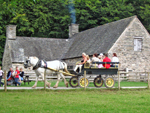 |
|
 |
|
 |
|
 |
|
 |
|
 |
| |
This trip we did not give so much time
in Wales. Infact, it originally was not on our route at all. The plan
was altered when my sister made notice to |
| |
us that the museum of welsh life is
so lively organized and is one of the thing we should not miss especially
when we are already around. We saw it |
| |
was true when we visited the museum. |
| |
The total ground of this museum is divided
into 3 main sections, 17 hectars for woodland (lower Ely conservation
area), 7.5 hectars for the St.Fagan |
| |
castle ground and 18 hectars for the
real open meseum. Besides the St. Fagan castle which lies there over
centuries before it was contributed to the |
| |
museum by the Earl of Plymouth in 1946,
most of the constructions were dismentled from elsewhere around Wales.They
show the lifestyle of people |
| |
of Wales from different generations,especially
during the few centuries ago. Also they show different industries
or businesses that Wales expertized |
| |
in the past. The historical civil war
for the last battle was nearby the Fagan village. They are demonstrated
also here. |
| |
|
| |
Walk along with us through the open
museum and get to know more of Wales. |
| |
|
| |
click on pics
to enlarge, The descriptions of each pic is on mouse over pic (no
click) |
| |
 |
|
 |
|
 |
|
 |
|
 |
|
| |
|
|
|
|
|
|
|
|
|
|
| |
 |
|
 |
|
 |
|
 |
|
 |
|
| |
|
|
|
|
|
|
|
|
|
|
| |
 |
|
 |
|
 |
|
 |
|
 |
|
| |
|
|
|
|
|
|
|
|
|
|
| |
 |
|
 |
|
 |
|
 |
|
 |
|
| |
|
|
|
|
|
|
|
|
|
|
| |
 |
|
 |
|
 |
|
 |
|
 |
|
| |
|
|
|
|
|
|
|
|
|
|
| |
 |
|
 |
|
 |
|
 |
|
 |
|
| |
|
|
|
|
|
|
|
|
|
|
| |
 |
|
 |
|
 |
|
 |
|
|
|
| |
|
|
|
|
|
|
|
|
|
|